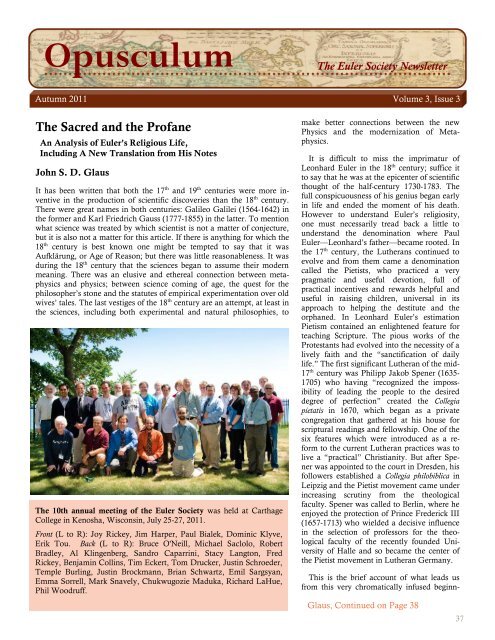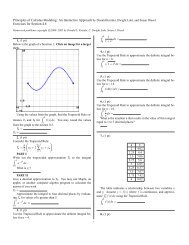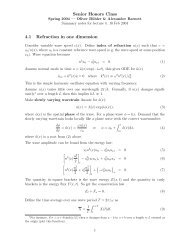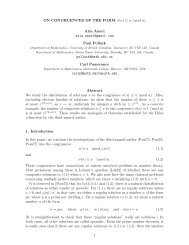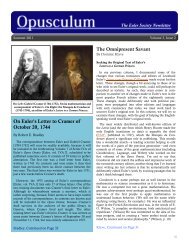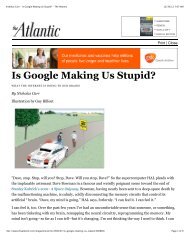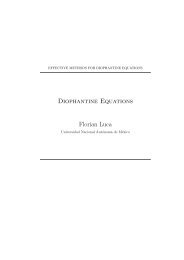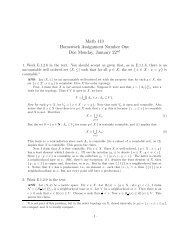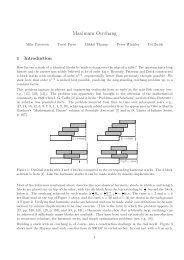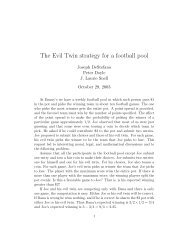Opusculum - Dartmouth College
Opusculum - Dartmouth College
Opusculum - Dartmouth College
Create successful ePaper yourself
Turn your PDF publications into a flip-book with our unique Google optimized e-Paper software.
<strong>Opusculum</strong><br />
The Euler Society Newsletter<br />
Autumn 2011 Volume 3, Issue 3<br />
The Sacred and the Profane<br />
An Analysis of Euler's Religious Life,<br />
Including A New Translation from His Notes<br />
John S. D. Glaus<br />
It has been written that both the 17 th and 19 th centuries were more inventive<br />
in the production of scientific discoveries than the 18 th century.<br />
There were great names in both centuries: Galileo Galilei (1564-1642) in<br />
the former and Karl Friedrich Gauss (1777-1855) in the latter. To mention<br />
what science was treated by which scientist is not a matter of conjecture,<br />
but it is also not a matter for this article. If there is anything for which the<br />
18 th century is best known one might be tempted to say that it was<br />
Aufklärung, or Age of Reason; but there was little reasonableness. It was<br />
during the 18 th century that the sciences began to assume their modern<br />
meaning. There was an elusive and ethereal connection between metaphysics<br />
and physics; between science coming of age, the quest for the<br />
philosopher’s stone and the statutes of empirical experimentation over old<br />
wives’ tales. The last vestiges of the 18 th century are an attempt, at least in<br />
the sciences, including both experimental and natural philosophies, to<br />
_____<br />
The 10th annual meeting of the Euler Society was held at Carthage<br />
<strong>College</strong> in Kenosha, Wisconsin, July 25-27, 2011.<br />
Front (L to R): Joy Rickey, Jim Harper, Paul Bialek, Dominic Klyve,<br />
Erik Tou. Back (L to R): Bruce O'Neill, Michael Saclolo, Robert<br />
Bradley, Al Klingenberg, Sandro Caparrini, Stacy Langton, Fred<br />
Rickey, Benjamin Collins, Tim Eckert, Tom Drucker, Justin Schroeder,<br />
Temple Burling, Justin Brockmann, Brian Schwartz, Emil Sargsyan,<br />
Emma Sorrell, Mark Snavely, Chukwugozie Maduka, Richard LaHue,<br />
Phil Woodruff.<br />
make better connections between the new<br />
Physics and the modernization of Metaphysics.<br />
It is difficult to miss the imprimatur of<br />
Leonhard Euler in the 18 th century; suffice it<br />
to say that he was at the epicenter of scientific<br />
thought of the half-century 1730-1783. The<br />
full conspicuousness of his genius began early<br />
in life and ended the moment of his death.<br />
However to understand Euler’s religiosity,<br />
one must necessarily tread back a little to<br />
understand the denomination where Paul<br />
Euler—Leonhard’s father—became rooted. In<br />
the 17 th century, the Lutherans continued to<br />
evolve and from them came a denomination<br />
called the Pietists, who practiced a very<br />
pragmatic and useful devotion, full of<br />
practical incentives and rewards helpful and<br />
useful in raising children, universal in its<br />
approach to helping the destitute and the<br />
orphaned. In Leonhard Euler’s estimation<br />
Pietism contained an enlightened feature for<br />
teaching Scripture. The pious works of the<br />
Protestants had evolved into the necessity of a<br />
lively faith and the ―sanctification of daily<br />
life.‖ The first significant Lutheran of the mid-<br />
17 th century was Philipp Jakob Spener (1635-<br />
1705) who having ―recognized the impossibility<br />
of leading the people to the desired<br />
degree of perfection‖ created the Collegia<br />
pietatis in 1670, which began as a private<br />
congregation that gathered at his house for<br />
scriptural readings and fellowship. One of the<br />
six features which were introduced as a reform<br />
to the current Lutheran practices was to<br />
live a ―practical‖ Christianity. But after Spener<br />
was appointed to the court in Dresden, his<br />
followers established a Collegia philobiblica in<br />
Leipzig and the Pietist movement came under<br />
increasing scrutiny from the theological<br />
faculty. Spener was called to Berlin, where he<br />
enjoyed the protection of Prince Frederick III<br />
(1657-1713) who wielded a decisive influence<br />
in the selection of professors for the theological<br />
faculty of the recently founded University<br />
of Halle and so became the center of<br />
the Pietist movement in Lutheran Germany.<br />
This is the brief account of what leads us<br />
from this very chromatically infused beginn-<br />
____<br />
Glaus, Continued on Page 38<br />
37
Issue Autumn #: [Date] 2011<br />
Volume Dolor 3, Sit Issue Amet 3<br />
Glaus, Continued from Page 37<br />
ing of the Pietist movement within Lutheranism to the<br />
end of the 17 th century when August Hermann Francke<br />
(1663-1727) became a professor and pastor in Glaucha<br />
near Halle in 1692. Francke is important since it is he<br />
who established the orphan asylum that is referenced in<br />
Euler’s own notes. On the whole, the Pietists were<br />
doctrinaire Lutherans preserving the content of Lutheran<br />
dogma but not the way in which it was to be delivered.<br />
The great schism that marked the Pietists was the<br />
renunciation of the Lutheran belief of justification by<br />
faith alone. The Pietists insisted on a life of ―active<br />
devotion, the doctrine of repentance, conversion and<br />
regeneration‖; these dogmatic institutions were called the<br />
Pietist conventicles and lead to regeneration through<br />
prayer, devout readings and exhortations. Even though<br />
Halle campaigned against the Pietists, and though it<br />
experienced a period of decline after the deaths of its<br />
founders Spener (1705), Francke (1727) and Joachim<br />
Justus Breithaupt (1732), the influence had already<br />
spread.<br />
King Frederick I and Frederick William I stipulated<br />
that all theologians who desired appointments in Prussia<br />
had to study at Halle for two years. However, Frederick<br />
William's successor Frederick II did not show any<br />
particular favor to them, though he did have a special<br />
affection for the Huguenot community in Prussia. In his<br />
old age he said that he was happy to have lived long<br />
enough to celebrate the Jubilee of the Revocation of the<br />
Edict of Nantes in 1785. Perhaps he wished to re-connect<br />
the religious colony with the skeptic colony, the Calvinist<br />
refugees with the philosophical redoubt, in which Pierre-<br />
Louis Moreau de Maupertuis (1698-1759), Jean Baptiste<br />
d’Argens (1701-1771), Jean le Rond d’Alembert (1717-<br />
1783), Julien Offrey de la Mettrie (1709-1751) and<br />
François Marie Arouet alias Voltaire (1694-1778) had<br />
their own brilliance. If however, Frederick II had<br />
conceived of such hope, he would have had to renounce<br />
it fairly quickly. The Protestant refugees would never<br />
have allowed themselves to be mistaken for freethinkers.<br />
So it was for the Pietists.<br />
Glaus, ____ Continued on Page 39<br />
The Euler Line<br />
The Old and the New<br />
L to R: Lutheran theologian<br />
and Pietist reformer Philipp<br />
Jakob Spener (1635-1705),<br />
Lutheran Pietist professor<br />
August Hermann Francke<br />
(1663-1727), and Frederick I of<br />
Prussia (1657-1713) [formerly<br />
Prince Frederick III]<br />
Three years ago, Suijun Jia and<br />
Ruifang Ren published a paper,<br />
"The development of Euler’s contribution<br />
to the concept of function" [in Chinese] in the<br />
Journal of Northwest University, Natural Sciences Edition 38 (3)<br />
(2008), pp. 513-516. The authors conclude that Euler’s<br />
perception of a function as an analytical expression was<br />
crucial to the transformation of the idea of function from a<br />
geometrical to an algebraic concept.<br />
A. M. Zubkov's paper, "Euler and combinatorial analysis"<br />
[in Russian] appeared two years ago in Istoriko-Matematicheskie<br />
Issledovaniya (2) 13 (48) (2009), pp. 38-48. The<br />
author surveys Euler’s work in graph theory, Latin squares<br />
and pentagonal numbers. A review by Radoslav M. Dimitric<br />
is available at Zentralblatt MATH 1202.01059.<br />
Detlef Spalt's paper, "Welche Funktionsbegriffe gab<br />
Leonhard Euler?" [in German], appears this month in<br />
Historia Mathematica 38 (2011) pp. 485-505. From the<br />
abstract: Leonhard Euler's notion of function as an<br />
"analytical expression," occasionally denoted by f (x), is well<br />
known. But it has gone unnoticed that Euler used a second<br />
well-defined notion of function for which he even coined a<br />
particular denotation: f :, used as f :x. In fact, this second<br />
notion of function is the earlier one, defined as "the ordinate<br />
which depends on the abscissa," given by the curve. Euler<br />
argues that this "geometric" notion of function is more<br />
general than the "algebraic" one. Consequently, Euler relies<br />
on this more general notion of function when he integrates<br />
functions of several variables.<br />
The Euler Archive made an appearance in the Chronicle of<br />
Higher Education, as John Bukowski's pick for the Chronicle's<br />
article on favorite online resources. Other resources<br />
that made the cut were Imaging the Iliad (an iPad app that<br />
combines text and images from the Iliad) and the Apple<br />
Examiner (a web site devoted to the tracking of ongoing<br />
upgrades and developments for Apple products).<br />
38 2
Issue Autumn #: [Date] 2011<br />
Volume Dolor 3, Sit Issue Amet 3<br />
On the Euler<br />
Circuit<br />
Recent meetings and<br />
colloquia on Euler<br />
Dominic Klyve gave two talks on Euler in April<br />
2011:<br />
"Clairaut, Euler, and Newton: the gravity crisis<br />
of the 1740's," at the Central Washington University<br />
Physics Colloquium, April 11.<br />
"The Life, Legacy, and Lost Library Books of<br />
Leonhard Euler," Department of Mathematics,<br />
Whitman <strong>College</strong>, April 14.<br />
Shippensburg University of Shippensburg,<br />
Pennsylvania, is using Leonhard Euler as the<br />
theme for their department colloquium series<br />
this year. More information is at<br />
www.ship.edu/Math/Current_Semester<br />
The Steller Society Commemorates Euler<br />
Georg Wilhelm Steller (1709-1746) was a member<br />
of the Imperial Russian Academy of Sciences<br />
in St. Petersburg who accompanied Vitus<br />
Bering at the Kamchatka Expedition and discovered<br />
the sea cow (which bears his name) in<br />
the Bering Sea in 1745. The Annual Meeting of<br />
the Steller Society in Halle, October 13-15 of<br />
this year, was partly devoted Euler.<br />
Ruediger Thiele spoke on "Euler and Pallas."<br />
Peter Simon Pallas (1741-1811) was professor<br />
of natural history at the St. Petersburg Academy.<br />
He joined scientific expeditions to Siberia<br />
(1768-1774) and Russia and is also known for<br />
iron meteorites (pallasites) and a long-haired<br />
cat (Pallas' cat).<br />
Another lecture was delivered by Michel<br />
Kowalewicz, University of Cracow, Poland.<br />
Kowalewicz, who is a professor of philosophy,<br />
commemorated the 100th anniversary of Euler's<br />
Opera Omnia. His talk was based mostly<br />
on unknown Russian archive material, which<br />
showed that it is not true that in the first years<br />
of the edition the Opera Omnia was primarily<br />
supported by the Swiss Euler Commission, but<br />
rather that the crucial support came from the<br />
Imperial Russian Academy, which had a strong<br />
interest in such an edition since the days of P.<br />
H. Fuss.<br />
Glaus, Continued from Page 38<br />
Perhaps the conclusion of this introduction should be from Euler<br />
himself, and there is no better document that reveals his selfdetermination<br />
than that of his ―Defense of the Divine Revelation<br />
against the Objections of the Freethinkers‖ [E92, 1747]:<br />
A reasonable creature cannot be happier, according to the measure<br />
of knowledge which has been apportioned to it, than when it has<br />
perfectly conformed its will to do the duties known to it and has<br />
fully assuaged all the desires which run contrary to them, so that<br />
there are no inclinations left, except those which conform to these<br />
duties. For whoever has put himself in such a state will enjoy true<br />
peace of mind and nothing can trouble his contentment. This<br />
contentment cannot be increased any further later on, unless the<br />
mind reaches a more perfect knowledge and at the same time the<br />
will is improved according to this same knowledge and becomes<br />
more and more submissive to the will of God.<br />
— J. S. D. Glaus<br />
PS. My grateful appreciation goes to Rüdiger Thiele and Karin Reich<br />
for their determination and assistance in assisting me from cobbled<br />
notes to a properly researched document.<br />
Excerpts From the Notes of Leonhard Euler<br />
Those of the venerated company of the Consistory have named me to a<br />
commission which has as its purpose to place the catechism onto a better footing.<br />
However, I do not think that I will find a better way to do so except by proposing<br />
the ways of my late father who used this method to provide more instruction and<br />
interest to this part of our religious service. He did so well that the example of his<br />
success was used in a few other churches. The catechisms were better attended<br />
than previously and the entire congregation has judged that they have found it as<br />
a better education than ordinary sermons.<br />
My father separated the youth into certain classes according to their gender<br />
and their capacity. Every Sunday afternoon, each of these classes met one after<br />
another and presented themselves to church and answered the questions that he<br />
asked them from certain sections of their catechism. Firstly, everyone recited the<br />
responses from the catechism word for word in an intelligible way and then my<br />
father explained the subject in greater detail and addressed them on the matter<br />
and added new questions, choosing one child and then another, without<br />
observing any type of order and they had to answer from their own knowledge.<br />
In order to achieve this he prepared them during the week having assembled<br />
them together twice at which they had to appear the following Sunday. In this<br />
way the children were able to fully answer the additional questions which he<br />
asked of them; and if one of them was not able to answer, he asked someone else<br />
which produced a very strong emulative effect and the occasions presented<br />
themselves in large numbers to all those present and the opportunities to address<br />
all present with questions and answers, to everyone’s benefit even if they had not<br />
studied.<br />
However what made these exercises even more interesting and which placed<br />
my father in a better position to usefully occupy the children and to have all of<br />
those present pay attention, was the very helpful use of a book of stories based on<br />
the Bible that the late Mr. Hubner had published under the title “Fifty-two<br />
stories taken from the Old and New Testaments” which contained questions,<br />
_____<br />
Glaus, Continued on Page 40<br />
39 3
Issue Autumn #: [Date] 2011<br />
Volume Dolor 3, Sit Issue Amet 3<br />
Glaus, Continued from Page 39<br />
moral quotations and thoughts which were relative. My<br />
father had a new edition made so that every child could<br />
obtain it at a very reasonable price. Every time that such a<br />
story was dealt with in the catechism which the children<br />
promptly answered to the attached questions, they<br />
continued on with the moral quotations and to the<br />
salutary reflections. The latter of these were conceived of in<br />
verse so that the children had to learn them by heart<br />
which provided new topics to support the entire group.<br />
Hubner’s work that was mentioned is undoubtedly<br />
well-known and it can always be used as a model to<br />
compose such a work in French which what I should hope<br />
will become even more perfect for the goal for which it is<br />
being offered. But it contains some shortcomings and it<br />
should be hoped that one of our ministers will undertake<br />
this task.<br />
We can easily admit that in this way by always joining<br />
a story from the Bible to our catechisms we will become<br />
much more instructive and interesting not only for the<br />
children but for all the members of the church. I can even<br />
assure you that because of the success that my father had<br />
these lessons will be better attended and a greater number<br />
of the public will come to the ordinary sermons. Perhaps it<br />
would be no more difficult to substitute them in the place<br />
of the sermons in the afternoon to the great relief of the<br />
Pastor. It would be expected that none of the special<br />
children wanted to have him drop this exercise and to this<br />
effect it is important to be careful in the distribution of<br />
these classes. If for example the chapel of the<br />
Fridrichofstatt was made available for catechism to the<br />
children from the orphanage and the charity school to<br />
which we can add the other poor children from the Colony<br />
we might be able to provide Werder with similar teaching<br />
to the children who are better off in such a way that no<br />
one would be upset. An exercise where children would<br />
become accustomed to speaking in public would also be<br />
very useful in other ways besides the wonderful<br />
information that they would receive on that occasion.<br />
I would not want that the minister to be in the pulpit<br />
during these teachings. He can fulfill these duties much<br />
more conveniently being on the floor in the middle of the<br />
children that are assembled each time; as important as it<br />
is to be in their midst as it is to be close to them to respond<br />
to their questions.<br />
It would also be good to have a Bible placed on a desk<br />
so that the children might be able to look up the passages<br />
which are part of the catechism and to make them read<br />
out loud which will help them to become familiar with the<br />
Holy Scripture and will maintain everyone’s attention.<br />
Such an arrangement in the beginning might very well<br />
encounter some difficulties, but once it is underway, may I<br />
dare to hope that everyone will look on it as one of the<br />
most important accomplishments of our Church.<br />
This house in Magedeburg, Germany (formerly Prussia), is the<br />
one in which Princess Charlotte Frederick lived during the Seven<br />
Years' War (1756-1763); she was the princess to whom Euler<br />
wrote his famous Lettres à une Princess d'Allemagne.<br />
Image courtesy of Ruediger Thiele<br />
References<br />
Euler, Leonhard: Handschriftliche Note Eulers über die Katechisierung,<br />
Archiv der Französischen Kirche in Berlin, AFrD Rep.<br />
04-1043, a-c.<br />
Euler, Leonhard (anonym): Die Rettung der Göttlichen Offenbarung<br />
gegen die Einwürfe der Freygeister. Berlin 1747. Italienische<br />
und französische Übersetzungen 1777 bzw. 1805.<br />
Euler, Leonhard: Lettres à une Princesse de Allemagne. St. Petersburg<br />
1768-1772. Deutsche Ausgabe „Briefe an eine deutsche<br />
Prinzessin―, 1769-1773, weitere Ausgaben bis zur Gegenwart.<br />
Hartweg, F.G.: Leonhard Eulers Tätigkeit in der französisch<br />
reformierten Kirche von Berlin, in: Die Hugenottenkirche 32, 4<br />
(1979) 14-125, 32, 5 (1979) 17-18.<br />
Raith, Michael: Der Vater Paulus Euler - Beiträge zum geistigen<br />
Verständnis der Herkunft Leonhard Eulers, in: Leonhard Euler.<br />
Gedenkband des Kantons Basel-Stadt. Hrg. J.J. Burkhardt u.a.<br />
Basel 1983, S. 459-470.<br />
Thiele, Rüdiger: Leonhard Euler, in: Mathematics and the Divine.<br />
Hrg. T. Koetsier und l. Bergmans. Amsterdam 2005, S. 509-521.<br />
Tholuck, A.: Vermischte Schriften, Bd. 1. Hamburg 1839.<br />
————————————————<br />
This work originally appeared in German as<br />
Leonhard Euler 1707-1783, Mathematiker – Mechaniker –<br />
Physiker Braunschweigisches Landesmuseum © 2008<br />
40 4
Issue Autumn #: [Date] 2011<br />
Volume Dolor 3, Sit Issue Amet 3<br />
An 18th Century Illustration of the Berlin Academy. Translation of the German<br />
description: View of the building of the large Royal Stable in the Dorotheen Quarter of Berlin<br />
which is now completely new, erected after it burnt down a few years ago. This very handsome<br />
building is for the Royal Academie of Sciences and Belles Lettres as well as for the Academy of Arts.<br />
Image and translation courtesy of Ruediger Thiele<br />
Translation and Archive Update<br />
Michael Saclolo of St. Edward's University in Austin, Texas has completed his<br />
translation of "Recherches physiques sur la nature des moindres parties de la<br />
matiere" ("Physical investigations on the nature of the smallest parts of matter")<br />
[E91]. This paper… It is currently available on the Euler Archive.<br />
Jasen Scaramazza of Rowan University has completed an English translation of<br />
"Recherches sur quelques integrations remarquables dans l'analyse des fonctions<br />
a deux variables connues sous le nom de differences partielles" ("Research into<br />
some remarkable integrations in the analysis of functions of two variables known<br />
as partial differential equations") [E724].<br />
Some high-quality scans of Euler's Vollständige Anleitung zur Algebra [E387-388]<br />
are available through the University of Köln:<br />
http://www.uni-koeln.de/math-nat-fak/didaktiken/mathe/volkert/Euler ueber<br />
negative Zahlen.pdf<br />
http://www.uni-koeln.de/math-nat-fak/didaktiken/mathe/volkert/Euler ueber<br />
figurierte Zahlen.pdf<br />
Two samples are shown below:<br />
<strong>Opusculum</strong> is the official newsletter of the<br />
Euler Society. It is published on a quarterly<br />
basis.<br />
<strong>Opusculum</strong> Staff & Volunteers<br />
Erik R. Tou, Editor<br />
Dominic Klyve, Columnist<br />
John S. D. Glaus, Contributor<br />
Letters, articles, and other contributions<br />
to the <strong>Opusculum</strong> are very welcome. Send<br />
any contributions, observations, or news<br />
items to Erik Tou at etou@carthage.edu.<br />
The mission of The Euler Society is threefold:<br />
It encourages scholarly contributions<br />
examining the life, research, and influence<br />
of Euler. The Society also explores<br />
current studies in the mathematical sciences<br />
that build upon his thought. And it<br />
promotes English translations of selections<br />
from his writings, including correspondence<br />
and notebooks.<br />
Euler Society Executive Committee<br />
Ronald S. Calinger, Chancellor<br />
Catholic University of America<br />
calinger@cua.edu<br />
Robert E. Bradley, President<br />
Adelphi University<br />
bradley@adelphi.edu<br />
Rüdiger Thiele, Vice President<br />
University of Leipzig<br />
ruediger.thiele3@freenet.de<br />
C. Edward Sandifer, Secretary<br />
Western Connecticut State University<br />
esandifer@earthlink.net<br />
Erik R. Tou, Treasurer<br />
Carthage <strong>College</strong><br />
etou@carthage.edu<br />
http://www.eulersociety.org<br />
The title image for this issue of <strong>Opusculum</strong> is a portion of the Baltic seacoast taken from the 1760 edition of the John Atlas S. Geographicus, D. Glaus, Ombudsman<br />
the compilation of which<br />
was supervised by Leonhard Euler. It is numbered as E205 in Eneström's Index, and is available on the Euler Archive.<br />
The Euler Society<br />
41 5<br />
restinn@roadrunner.com


